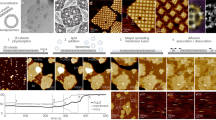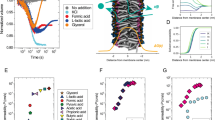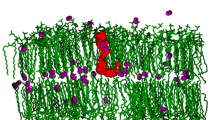Abstract
THE cell membrane is viewed at present as a two-dimensional solution in which the lipid bilayer acts as a viscous ‘solvent’ for oriented integral proteins1. Accepting this model as a working hypothesis, questions arise as to the nature of the hydrophobic interior of the bilayer and what rules proteins, lipoproteins, or polypeptides obey in interacting with it. The simplest hypothesis for the interior is that it is equivalent to a bulk alkyl solvent (albeit a very thin one). If this hypothesis is correct, the enthalpy of transfer (ΔH) of a solute molecule (for example, an alkane) from a bulk alkyl solvent to the bilayer interior should be small. That is, the solute-solvent interaction energy should be about the same in the bilayer as in the bulk alkyl. I have examined this hypothesis experimentally by measuring the solubility of n-hexadecane in planar bilayer membranes formed from glycerol-1-monooleate (1-GMO). The acyl chain of 1-GMO is approximately equivalent to 1-heptadecene. The enthalpy of transfer of n-hexadecane from pure liquid into 1-heptadecene can be estimated from solubility parameter theory2 to be only a few calories per mol. Thus, the mixing of n-hexadecane in the bilayer interior should be nearly athermal: I have found, however, that δH is orders of magnitude larger than expected. This result has important implications for understanding the bilayer as a two-dimensional solution.
This is a preview of subscription content, access via your institution
Access options
Subscribe to this journal
Receive 51 print issues and online access
$199.00 per year
only $3.90 per issue
Buy this article
- Purchase on Springer Link
- Instant access to full article PDF
Prices may be subject to local taxes which are calculated during checkout
Similar content being viewed by others
References
Singer, S. J., and Nicolson, G. L., Science, 175, 720–731 (1972).
Hildebrand, J. H., Prausnitz, J. M., and Scott, R. L., Regular and Related Solutions, (Van Nostrand Reinhold, New York, 1970).
Mueller, P., Rudin, D. O., Tien, H. T., and Westcott, W. C., Circulation, 26, 1167–1170 (1962).
White, S. H., Biochim. biophys. Acta, 196, 354–357 (1970); Biophys, J., 10, 1127–1148 (1970).
White, S. H., Biochim. biophys. Acta, 356, 8–16 (1974); Biophys, J., 15, 95–117 (1975).
Henn, F. A., and Thompson, T. E., J. molec Biol., 31, 227–235 (1968).
Andrews, D. M., and Haydon, D. A., J. molec. Biol, 32, 149–150 (1968).
White, S. H., and Thompson, T. E., Biochim. biophys. Acta 323, 7–22 (1973).
White, S. H., and Blessum, D. N., Rev. Sci. Iustrum., 46, 1462–1466 (1975).
Fettiplace, R., Andrews, D. M., and Haydon, D. A., J. Membr. Biol., 5, 277–296 (1971).
Pagano, R. E., Ruysschaert, J. M., and Miller, I. R., J. Membr. Biol., 10, 11–30 (1972).
Gershfeld, N. L., and Pagano, R. E., J. phys. Chem., 76, 1231–1237 (1972).
Katz, Y., Biophys. J., 16, 52a (1976).
Simon, S. A., Stone, W. L., and Busto-Latorre, P., Biophys. J., 16, 137a (1976).
Dean, R. B., and Hayes, K. E., J. Am. chem. Soc., 74, 5982–5984, (1952).
White, S. H., Biophys. J., 16, 193a (1976).
Requena, J., and Haydon, D. A., Proc. R. Soc., A 347, 161–177 (1975).
Lesslauer, W., and Blasie, J. K., Biophys. J., 12, 175–190 (1972).
Author information
Authors and Affiliations
Rights and permissions
About this article
Cite this article
WHITE, S. The lipid bilayer as a ‘solvent’ for small hydrophobic molecules. Nature 262, 421–422 (1976). https://doi.org/10.1038/262421a0
Received:
Accepted:
Published:
Issue Date:
DOI: https://doi.org/10.1038/262421a0
This article is cited by
-
Cubic-to-inverted micellar and the cubic-to-hexagonal-to-micellar transitions on phytantriol-based cubosomes induced by solvents
Drug Delivery and Translational Research (2020)
-
Membrane Partitioning: “Classical” and “Nonclassical” Hydrophobic Effects
The Journal of Membrane Biology (2011)
-
Location of hexane in lipid bilayers determined by neutron diffraction
Nature (1981)
Comments
By submitting a comment you agree to abide by our Terms and Community Guidelines. If you find something abusive or that does not comply with our terms or guidelines please flag it as inappropriate.



